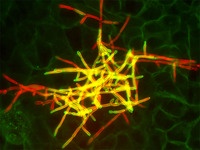Duncan Wilson, Donna MacCallum & Adilia Warris

The immune cells which drive this response, neutrophils, produce high levels of the protein calprotectin. This protein has two functions: to recruit further neutrophils, and to bind zinc, thus limiting microbial access to this essential trace mineral.
We have found that this reduction in zinc triggers the production of the fungal protein Pra1 by Candida. Strikingly, fungal Pra1 also binds zinc and also attracts neutrophils.
We predict that host calprotectin and fungal Pra1 form a vicious “pro-inflammatory cycle” of neutrophil recruitment. We will test this hypothesis by measuring calprotectin levels in individuals susceptible to candidiasis. Furthermore, we will determine the effects of host calprotectin, fungal Pra1 and zinc on the migration of immune cells using human blood models.
The information gained in this project will help us to understand the mechanisms underlying candidiasis and has significant potential to lead to novel forms of therapy, such as local zinc supplementation or targeted neutralisation of zinc-binding molecules.
